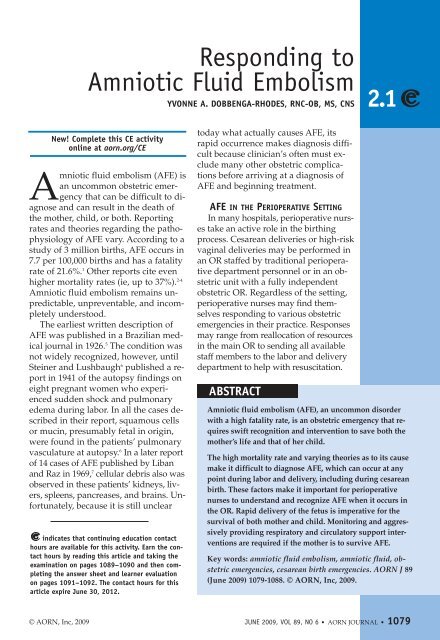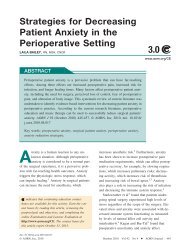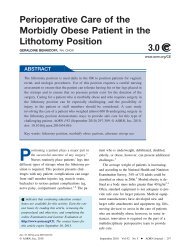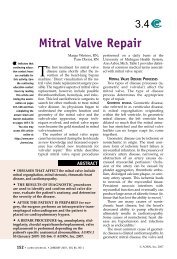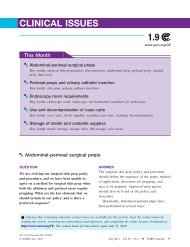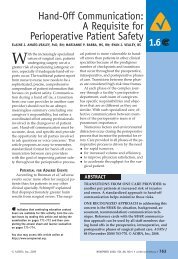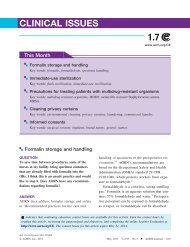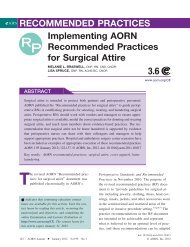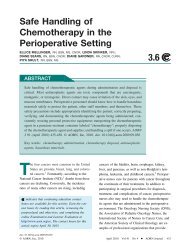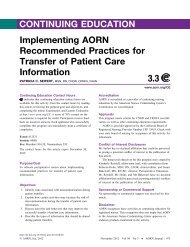Responding to Amniotic Fluid Embolism - AORN
Responding to Amniotic Fluid Embolism - AORN
Responding to Amniotic Fluid Embolism - AORN
Create successful ePaper yourself
Turn your PDF publications into a flip-book with our unique Google optimized e-Paper software.
<strong>Responding</strong> <strong>to</strong><strong>Amniotic</strong> <strong>Fluid</strong> <strong>Embolism</strong>YVONNE A. DOBBENGA-RHODES, RNC-OB, MS, CNS2.1New! Complete this CE activityonline at aorn.org/CE<strong>Amniotic</strong> fluid embolism (AFE) isan uncommon obstetric emergencythat can be difficult <strong>to</strong> diagnoseand can result in the death ofthe mother, child, or both. Reportingrates and theories regarding the pathophysiologyof AFE vary. According <strong>to</strong> astudy of 3 million births, AFE occurs in7.7 per 100,000 births and has a fatalityrate of 21.6%. 1 Other reports cite evenhigher mortality rates (ie, up <strong>to</strong> 37%). 2-4<strong>Amniotic</strong> fluid embolism remains unpredictable,unpreventable, and incompletelyunders<strong>to</strong>od.The earliest written description ofAFE was published in a Brazilian medicaljournal in 1926. 5 The condition wasnot widely recognized, however, untilSteiner and Lushbaugh 6 published a reportin 1941 of the au<strong>to</strong>psy findings oneight pregnant women who experiencedsudden shock and pulmonaryedema during labor. In all the cases describedin their report, squamous cellsor mucin, presumably fetal in origin,were found in the patients’ pulmonaryvasculature at au<strong>to</strong>psy. 6 In a later repor<strong>to</strong>f 14 cases of AFE published by Libanand Raz in 1969, 7 cellular debris also wasobserved in these patients’ kidneys, livers,spleens, pancreases, and brains. Unfortunately,because it is still unclearindicates that continuing education contacthours are available for this activity. Earn the contacthours by reading this article and taking theexamination on pages 1089–1090 and then completingthe answer sheet and learner evaluationon pages 1091–1092. The contact hours for thisarticle expire June 30, 2012.<strong>to</strong>day what actually causes AFE, itsrapid occurrence makes diagnosis difficultbecause clinician’s often must excludemany other obstetric complicationsbefore arriving at a diagnosis ofAFE and beginning treatment.AFE IN THE PERIOPERATIVE SETTINGIn many hospitals, perioperative nursestake an active role in the birthingprocess. Cesarean deliveries or high-riskvaginal deliveries may be performed inan OR staffed by traditional perioperativedepartment personnel or in an obstetricunit with a fully independen<strong>to</strong>bstetric OR. Regardless of the setting,perioperative nurses may find themselvesresponding <strong>to</strong> various obstetricemergencies in their practice. Responsesmay range from reallocation of resourcesin the main OR <strong>to</strong> sending all availablestaff members <strong>to</strong> the labor and deliverydepartment <strong>to</strong> help with resuscitation.ABSTRACT<strong>Amniotic</strong> fluid embolism (AFE), an uncommon disorderwith a high fatality rate, is an obstetric emergency that requiresswift recognition and intervention <strong>to</strong> save both themother’s life and that of her child.The high mortality rate and varying theories as <strong>to</strong> its causemake it difficult <strong>to</strong> diagnose AFE, which can occur at anypoint during labor and delivery, including during cesareanbirth. These fac<strong>to</strong>rs make it important for perioperativenurses <strong>to</strong> understand and recognize AFE when it occurs inthe OR. Rapid delivery of the fetus is imperative for thesurvival of both mother and child. Moni<strong>to</strong>ring and aggressivelyproviding respira<strong>to</strong>ry and circula<strong>to</strong>ry support interventionsare required if the mother is <strong>to</strong> survive AFE.Key words: amniotic fluid embolism, amniotic fluid, obstetricemergencies, cesarean birth emergencies. <strong>AORN</strong> J 89(June 2009) 1079-1088. © <strong>AORN</strong>, Inc, 2009.© <strong>AORN</strong>, Inc, 2009 JUNE 2009, VOL 89, NO 6 • <strong>AORN</strong> JOURNAL • 1079
JUNE 2009, VOL 89, NO 6Dobbenga-RhodesThe abrupt onset of AFE may catch the bedsidecare provider unprepared. This event canhappen in any location, even during a cesareanbirth. 1 The devastating and rapid effects ofAFE, coupled with its low incidence, oftenlead nurses and obstetricians down a path ofexclusion before identifying AFE as the causeof the series of rapidly unfolding events. Someof the other obstetric or medical emergenciesthat must be considered include septic shock,anaphylactic shock, placental abruption,eclamptic seizure, uterine rupture, transfusionreaction, <strong>to</strong>xic response <strong>to</strong> local anesthetic, orsudden cardiac insult. 8 Preparation for AFEemergencies should be included in emergencydrills in both the perioperative and obstetricunits.THEORIES ABOUT AFEReluctance <strong>to</strong> label an obstetric emergencyas a true AFE occurs because of a lack of consensuson the actual pathophysiologic processtaking place in the individual maternal patient.The hypothesis of pulmonary vasculaturecongested by fetal squamous cells tha<strong>to</strong>riginated in the 1940s has been integral <strong>to</strong> obstetricemergency management for the last 60years. Many ensuing case studies have supportedthis traditional description. 3,9 Case studiesalso have shown that certain risk fac<strong>to</strong>rs arepossible causes of AFE, such as• age greater than 35 years; 1,3,4,10-12• amniocentesis; 13,14• artificial rupture of membranes; 3,4• cervical laceration; 3,11• cervical suture removal; 10,13• cesarean birth; 1,8-11,15,16• eclampsia; 1,11• fetal demise; 4,15,17• fetal distress; 3,11• fetal macrosomia; 4,10-12,15• instrumented vaginal delivery (eg, with forcepsor vacuum-assisted); 1,3,11,15• medical induction of labor; 3,10,11,15,18,19• multiparity; 3,4,10,12,20• multiple gestation (ie, two or more fetuses); 11,21,22• placenta previa; 1-3,11,21• placental abruption; 1,2,3,11,15,21• polyhydramnios; 11• rapid and intense labor; 4,6,10,13,15,20• therapeutic abortion; 10,14,16 and• uterine rupture. 3,4,10,11,15,23With the increase in cesarean births from20.7% in 1996 <strong>to</strong> 31.1% in 2006, an increased riskof both maternal and neonatal mortality hasbeen reported during elective cesarean birth ascompared <strong>to</strong> vaginal birth. 24,25 This increase incomplications suggests the need for a broadergrasp of the pathophysiology of AFE. It alsosuggests the need <strong>to</strong> provide better education <strong>to</strong>nurses who assist with cesarean births <strong>to</strong> increaseAFE awareness and recognition. Sharingthis knowledge with colleagues allows for collaborationduring equipment procurement andemergency response. Current theories about thecause of AFE differ.BIPHASIC CARDIAC FAILURE. A recent theory aboutAFE is that it is a biphasic response of shortlived,right ventricular cardiac failure with aninitial acute pulmonary hypertension. 26 The resultingright heart failure and associated hypoxiamay account for patients who experienceearly, sudden death during labor and delivery.Despite the brevity of this phase, 50% ofall maternal deaths occur in the first hour afterdelivery. 10,27,28The remaining 50% of maternal deaths occurduring the second, longer biphasic responsewhen left ventricular failure occurs. A maternalpatient in a postanesthesia care unit (PACU)should be moni<strong>to</strong>red closely after cesarean birth,especially if any of the aforementioned risk fac<strong>to</strong>rsare present. Decreased left-sided ventricularfilling and consequent systemic hypotensioncan occur during this postdelivery period.These cardiac events trigger an increase in pulmonarycapillary wedge pressure; pulmonaryartery pressure; and, consequently, right-sidedventricular filling pressure and elevated centralvenous pressure. 29Both Clark et al 30 in the United States andTuffnell 2 in the United Kingdom have establishednational registries for suspected clinicaloccurrences of biphasic AFE. They agree on fourhallmark signs of AFE:• acute hypotension or cardiac arrest;• acute hypoxia;• coagulopathy or severe clinical hemorrhagein the absence of other explanations; and• all of these events must occur during labor,1080 • <strong>AORN</strong> JOURNAL
Dobbenga-Rhodes JUNE 2009, VOL 89, NO 6cesarean birth, or dilatation and evacuationwithin 30 minutes postpartum. 2,30Clark et al have added one additional qualifier:• absence of any other significant confoundingcondition or potential explanation of thehallmark signs and symp<strong>to</strong>ms. 30One case report cautions that systemic hypo -tension actually may be absent in patients withcoexisting eclampsia. 16MULTI-ORGAN COLLAPSE. Another theory identifiesleft ventricular dysfunction, acute lung injury,and clotting fac<strong>to</strong>r activation as the root causesthat lead the patient <strong>to</strong> a rapid multi-organ collapseor shock. 31 This swift sequence of eventsends with a neurologic response <strong>to</strong> the respira<strong>to</strong>ryand hemodynamic injury. The neurologicmanifestations may include seizures, confusion,or coma. 32,33 DIAGNOSIS AND TREATMENTAccording <strong>to</strong> the national registries establishedby Clark et al 30 and Tuffnell, 2 70% of patientswere in labor when AFE occurred. 3Emergent evacuation of a gravid uterus willallow additional resuscitative measures <strong>to</strong> takeplace if AFE occurs before delivery. Early diagnosisof AFE for the still-pregnant woman isthe key <strong>to</strong> her survival. There is no standarddiagnostic scheme <strong>to</strong> confirm AFE and, unfortunately,there is no time <strong>to</strong> waste.Table 1 presents a nursing care plan for patientswho experience AFE. Preplanning is notpossible because of the emergent nature ofthis condition. In addition <strong>to</strong> the previouslyidentified hallmark signs, the nurse should bealert for rapid decreases in blood pressure,sudden difficulty breathing, or any unexplainedhemorrhage.TREATMENT RESPONSE. A prompt cesarean birthis crucial. 19 Facilitating such a quick deliverymay mean performing a perimortem cesareandelivery in a nonsurgical setting (eg, laborroom, birthing room) when it is necessary <strong>to</strong>save time by not transporting the patient <strong>to</strong>the OR. Some sources advocate delivery withinthree <strong>to</strong> four minutes of maternal collapseand the implementation of advanced cardiaclife support pro<strong>to</strong>cols. 13,19,33 A rapid response bythe perioperative team <strong>to</strong> the nonsurgical settingwill support all the care providers as wellIn some instances where amnioticfluid embolism occurs before or duringdelivery, the fetus also is placed in alife-threatening situation. Deliverywill increase the chance of fetal aswell as maternal survival.as bring surgical expertise <strong>to</strong> the patient.DELIVERY OF THE FETUS. In some instances whereAFE occurs before or during delivery, the fetusalso is placed in a life-threatening situation. Deliverywill increase the chance of fetal as well asmaternal survival. The weight of the graviduterus on the inferior vena cava impedes bloodreturn <strong>to</strong> the maternal heart and decreases systemicblood pressure. Delivering the fetus assoon as possible when maternal arrest occursleads <strong>to</strong> a more favorable neonatal outcome. 32,34,35If the AFE occurs before delivery, it leads <strong>to</strong> afatal outcome for the fetus in 21% of all cases,while 50% of the surviving neonates show aneurologic deficit. 19MATERNAL OXYGENATION AND MONITORING. After deliveryhas been facilitated and the neonatal teamhas assumed care for the baby, all efforts can beturned <strong>to</strong> the maternal patient’s resuscitation.Basic and advanced cardiac life support stepsshould already be in place. Oxygenation is thekey <strong>to</strong> avoiding irreversible neurologic injuryfor the patient. Early tracheal intubation andmechanical ventilation are usually necessary <strong>to</strong>maintain normal oxygen saturation. 13 Moni<strong>to</strong>ringof the patient with AFE includes continuouselectrocardiographic (ECG) moni<strong>to</strong>ring, pulseoximetry, and end-tidal carbon dioxide moni<strong>to</strong>ring.Clinicians should moni<strong>to</strong>r the patient’sblood pressure continuously, if possible. 10 Thesenoninvasive moni<strong>to</strong>rs and ventila<strong>to</strong>rs are standardin ORs, but may not be immediately availablein the obstetric department. If that is the<strong>AORN</strong> JOURNAL • 1081
JUNE 2009, VOL 89, NO 6Dobbenga-RhodesTABLE 1Nursing Care Plan for Patients Who Experience<strong>Amniotic</strong> <strong>Fluid</strong> <strong>Embolism</strong> [applicable PNDS code]DiagnosisRisk forineffectivecoping [X68];compromisedfamily coping[X14]; interruptedfamilyprocesses[X15]; andrisk forimpairedparent/infant/childattachment[X39]Nursing interventions• Identifies psychosocial status [I68] and barriers<strong>to</strong> communication [I134], determinesknowledge level [I135], and notes sensoryimpairment [I90].• Assesses readiness <strong>to</strong> learn [I136] and copingmechanisms [I137].• Elicits family members’ perceptions of surgery[I32].• Identifies individual values and wishes concerningcare [I63].• Verifies consent for the planned procedure[I124].• Explains expected sequence of events and reinforcesteaching about treatment options [I56].• Implements measures <strong>to</strong> provide psychologicalsupport [I147].• Includes the patient and family members inpreoperative teaching [I79] and dischargeplanning [I80] and provides time for the patientand family members <strong>to</strong> ask questions.• Provides status reports <strong>to</strong> family members[I109].• Provides information and explains thePatient Self-Determination Act [I103].• Evaluates psychosocial response <strong>to</strong> the planof care [I147].• Assesses risk for inadvertent hypothermia[I131].• Implements thermoregulation measures [I78]by:• ensuring ongoing intraoperative andpos<strong>to</strong>perative moni<strong>to</strong>ring of core bodytemperature with the appropriate method(eg, tympanic, distal eso phagus, naso -pharynx, pulmonary artery);• preheating the OR and postanesthesiacare unit (PACU) <strong>to</strong> 26° C (78.8° F);• using effective skin-surface warming methods(eg, forced-air warming, circulatingwatergarments, energy transfer pads) preoperativelyand intraoperatively and contin -uing their use in the PACU as needed;• warming IV and irrigation solutions <strong>to</strong>near 37° C (98.6° F) with appropriatewarming equipment according <strong>to</strong> manufacturers’instructions; and• assisting the anesthesia care provider <strong>to</strong>humidify and warm the patient’s airway.• Evaluates response <strong>to</strong> thermoregulationmeasures [I55].Outcomeindica<strong>to</strong>rThe patient,when applicable,and family membersverbalize understandingofthe procedure,sequence ofevents, and expectedoutcomes;demonstrateknowledge ofemotional responses<strong>to</strong> surgeryand the diseaseprocess; andverbalize de -creased anxietyand an ability <strong>to</strong>cope through outthe perioperativeperiod.The parent and infantdemonstrateappropriate bonding.OutcomestatementThe patien<strong>to</strong>r familymembersdemonstrateknowledgeof expectedresponses <strong>to</strong>the surgicalprocedure[O31].The patien<strong>to</strong>r familymembersparticipate indecisionsaffecting theperioperativeplan of care[O23].Risk forbody temperatureimbalance[X57]The patient’stemperature isgreater than 36° C(96.8° F) at thetime ofdischarge fromthe OR.The patientis at orreturning <strong>to</strong>normothermyat the conclusionof theimmediatepos<strong>to</strong>perativeperiod[O12].1082 • <strong>AORN</strong> JOURNAL
Dobbenga-Rhodes JUNE 2009, VOL 89, NO 6TABLE 1 (continued)Nursing Care Plan for Patients Who Experience<strong>Amniotic</strong> <strong>Fluid</strong> <strong>Embolism</strong> [applicable PNDS code]DiagnosisDecreasedcardiacoutput [X8];risk forfluidvolumeimbalance[X20];impairedgasexchange[X21]; andineffectivebreathingpattern [X7]Nursing interventions• Identifies baseline cardiac status [I59], respira<strong>to</strong>rystatus, and fluid volume status related <strong>to</strong> the patient’sdiagnosis.• Assesses preoperative condition according <strong>to</strong>physiological parameters (eg, vital signs, pulses,skin integrity, cardiac rhythm and dysrhythmias,breath sounds) and pertinent labora<strong>to</strong>ry studies.• Identifies fac<strong>to</strong>rs associated with an increasedrisk for hemorrhage or fluid and electrolyte loss[I132].• Uses moni<strong>to</strong>ring equipment <strong>to</strong> assess cardiac status[I120] and respira<strong>to</strong>ry status [I121].• Recognizes and reports deviations in arterialblood gas studies [I110] and deviations in diagnosticstudy results [I111].• Establishes IV access [I34], collaborates in fluidand electrolyte management [I23], administerselectrolyte therapy as prescribed [I5], and prescribedmedications based on arterial blood gasresults [II9].• Implements hemostasis techniques [I133] and administersblood product therapy as prescribed [I2].• Evaluates pos<strong>to</strong>perative cardiac status [I44] andrespira<strong>to</strong>ry status.• Evaluates response <strong>to</strong> administration of fluidsand electrolytes [I153].• Identifies physical alterations that require additionalprecautions for procedure-specific positioning[I64].• Verifies presence of prosthetics or corrective devices[I127].Positions the patient [I96].• Transports the patient according <strong>to</strong> individualneeds [I42].• Assesses the patient’s susceptibility for infection[I21].Implements aseptic technique [I70].• Minimizes the length of the invasive procedureby planning care efficiently [I85].Initiates traffic control [I81].Performs skin preparation [I94].• Classifies the surgical wound [I22] and administersprescribed prophylactic treatments [I10].Protects from cross contamination [I98].• Encourages deep breathing and coughing exercises[I33].• Evaluates for signs and symp<strong>to</strong>ms of injury as aresult of positioning [I38] or skin and tissue injuryas a result of transfer or transport [I42].• Moni<strong>to</strong>rs for signs and symp<strong>to</strong>ms of infection [I88].Outcomeindica<strong>to</strong>rThe patient’svital signs andhemodynamicstatus are withinthe expectedrange at transfer<strong>to</strong> the PACU andthe patient’s skinshows adequateperfusion atdischarge fromthe OR.OutcomestatementThe patient’scardiovascularstatus[O15];respira<strong>to</strong>rystatus [O14];and fluid,electrolyte,and acid-basebalances[O13] areconsistentwith orimprovedfrom baselinelevels establishedpreoperatively.Risk forperioperativepositioninginjury [X40];risk forimpairedskinintegrity[X51]; andrisk forinfection[X28]The patient’s skinremains intact,non-reddened,and free of blistering;and motion,sensation,and circulationare maintainedor improved duringthe perioperativeperiod.The patient isafebrile and hasa clean, primarilyclosed surgicalwound that isfree from signsor symp<strong>to</strong>ms ofinfection (eg,pain, redness,swelling) atdischarge fromthe OR.The patient isfree fromsigns andsymp<strong>to</strong>ms ofinjury related<strong>to</strong> positioning[O5].The patient isfree of signsand symp<strong>to</strong>msof injuryrelated<strong>to</strong> transfer/transport[O8].The patient isfree fromsigns andsymp<strong>to</strong>ms ofinfection[O10].<strong>AORN</strong> JOURNAL • 1083
JUNE 2009, VOL 89, NO 6Dobbenga-Rhodescase, caregivers should transport the patient <strong>to</strong>the OR as quickly and safely as possible. Ongoingcare should be shared between the perinataland perioperative nursing staff members. Manyperinatal units do not require staff members <strong>to</strong>be certified in advanced cardiac life support, sothe advanced education and experience of perioperativenurses will complement the basic lifesupport measures already implemented.CIRCULATORY SUPPORT. In accordance with thebasics of cardiopulmonary resuscitation, circula<strong>to</strong>rysupport is the next goal in the resuscitationof the patient with AFE. Medical andnursing staff members should quickly establisha large-bore peripheral IVcatheter, a central venouspressure catheter, a pulmo -nary artery catheter, and aperipheral arterial line. Gatheringadditional resources andmanpower from the anesthesiaand critical care staffs will helpsupport the resuscitation teamduring this emergency. 36,37Transthoracic or transesopha -geal echocardio graphy (TEE) isoften necessary <strong>to</strong> evaluate cardiacfunction and <strong>to</strong> guidetreatment, along with a 12-leadECG. 3 As time allows and asequipment is made available,the TEE may demonstrate theacute right ventricular overload,severe pulmonary arteryhypertension, and marked dias<strong>to</strong>lic dysfunctionof the left ventricle secondary <strong>to</strong> a dilated rightventricle. 29,38Use of the peripheral IV catheter should belimited <strong>to</strong> loading with crystalloid, colloid,packed cells, fresh frozen plasma, and platelets.If profound hemorrhage occurs, a transfusionof uncross-matched O-negative packed cells isrecommended so transfusion is not delayed bywaiting for type-specific and cross-matchedblood. 15 Hemofiltration 39 or plasma exchange 40may be effective in clearing the maternal plasmaof potential fetal debris. 10 Hemofiltration isthe removal of waste product from the bloodby passing it through extracorporeal filters.Plasma exchange consists of removal of blood,These patients arepredisposed <strong>to</strong> pulmonaryedema so their centralline readings should bemoni<strong>to</strong>red closely <strong>to</strong>avoid over-hydration.separation of blood cells from plasma, and returnof these blood cells <strong>to</strong> the body’s circulation,diluted with fresh plasma. A transfusion of1.5 times the maternal blood volume may act asa complete exchange transfusion; 41 however,cryo precipitate is particularly useful in AFEbecause it can be used <strong>to</strong> replenish clotting fac<strong>to</strong>rsin lieu of fresh frozen plasma in volumerestrictedpatients. In addition, cryoprecipitatecontains both fibrinogen and fibronectin, whichfacilitate the removal of cellular and particulatematter from the blood via the reticuloendothelial(ie, the mononuclear phagocyte) system. 33,42Thrombocy<strong>to</strong>penia can be treated with the administrationof platelets. 36Arterial lines can be used <strong>to</strong>regulate pressures, moni<strong>to</strong>roxygen saturation, and assistwith titration of inotropes.Specific inotropic medicationssuch as dopamine, dobutamine,and norepinephrine enhancehemodynamic stabilityby maintaining cardiac outputand blood pressure. Readingsfrom central lines should bemoni<strong>to</strong>red closely <strong>to</strong> avoidover-hydration of these patientswho are predisposed <strong>to</strong>pulmonary edema. Noncardiogenicpulmonary edemadevelops in 70% of AFE patients,possibly because of theeffect of various media<strong>to</strong>rs ofanaphylaxis such as histamine and bradykininsleading <strong>to</strong> capillary leak syndrome. 43 The anesthesiacare provider can draw blood specimensfrom these lines and send them for analysis <strong>to</strong>assist with interpretation and correction of coagulopathyas well as for cy<strong>to</strong>logic analysis foramniotic fluid in the maternal patient’s circulation.33 Rapid assessments may be availablefrom a point-of-care device, typically accessiblein the perioperative setting.Nursing personnel should see that coagulationstudies for prothrombin time, partialthromboplastin time, D-dimer, fibrin split products,and platelets are sent immediately <strong>to</strong> thelabora<strong>to</strong>ry for analysis. Coagulopathy and hemorrhageare common and often occur after the1084 • <strong>AORN</strong> JOURNAL
Dobbenga-Rhodes JUNE 2009, VOL 89, NO 6clinical diagnosis of AFE is made. 42 Disseminatedintravascular coagulation (DIC) is found in83% of patients with AFE. Half of these patientsmay develop coagulopathy within four hours ofthe onset of the clinical symp<strong>to</strong>ms. 36 Anesthesiapersonnel may use low-dose heparin <strong>to</strong> slowthe coagulation cascade and thus treat the consumptivecoagulopathy, although this practice iscontroversial. 15Coexistent hemorrhage may be related <strong>to</strong>uterine a<strong>to</strong>ny; however, the etiology of thehemorrhage is obscure, and it is thought thatconsumptive coagulopathy may lead <strong>to</strong> it. 44 Incontrast, increased fibrinolysis has been shown<strong>to</strong> occur in AFE, and it has been suggested thatan elevated plasminogen activa<strong>to</strong>r inhibi<strong>to</strong>r-1antigen in amniotic fluid may become active inthe maternal blood and contribute <strong>to</strong> DIC. 45Nursing staff members may implementuterine massage, and the physician may administerthe traditional oxy<strong>to</strong>cic medicationssuch as oxy<strong>to</strong>cin, methylergonovine maleate,carboprost tromethamine, or misopros<strong>to</strong>l <strong>to</strong>correct uterine a<strong>to</strong>ny. 34 These medications maybe given intravenously or directly in<strong>to</strong> theuterine musculature during life-saving measures<strong>to</strong> control the uterine a<strong>to</strong>ny and bleeding.If the a<strong>to</strong>ny or hemorrhage remains uncontrolled,many obstetricians attempt other surgicalinterventions such as ligation or embolizationof the inguinal or uterine arteries ormay resort <strong>to</strong> performing a <strong>to</strong>tal abdominalhysterec<strong>to</strong>my <strong>to</strong> arrest the hemorrhage. 33,46NEWER TREATMENT MODALITIES. Newer, breakthrough,modalities of treatment and supportivemanagement with AFE haveshown promise in individualcase presentations and havedemonstrated the uncommonnature of AFE, in that no twopatients will respond the sameway <strong>to</strong> the insult or <strong>to</strong> the therapy.Many of these items aremore easily accessed in themain OR than in the labor anddelivery department (Table 2).These items include extracorporealmembrane oxygenation,intra-aortic balloon counterpulsation, 47 cell salvage, cardio -pulmonary bypass, 45 nitric oxide administrationunder TEE guidance, 29,48 administration ofrecombinant fac<strong>to</strong>r VIIa, 37,49,50 and placement ofa right ventricular assist device <strong>to</strong> treat pulmonaryhypertension. 37 Cell salvage with man -da<strong>to</strong>ry leukocyte depletion filters also may offerthe ability <strong>to</strong> clear the maternal vasculature ofcontaminants. 51 Hemodialysis for renal failure 18has been used as well. Inhaled prostacycline hasbeen used <strong>to</strong> treat refrac<strong>to</strong>ry hypoxemia. 52Clark et al 30 have suggested that in light ofthe similarities of AFE <strong>to</strong> anaphylaxis, high-dosecorticosteroids and epinephrine may be usefuladjuvants. 30 Administration of hydrocortisonesodium succinate will control an inflamma<strong>to</strong>ryresponse. 33 This unique emergency also has beentermed “anaphylac<strong>to</strong>id syndrome of pregnancy”because of its similarities <strong>to</strong> anaphylaxis. 36After initial resuscitative efforts after AFE,nurses should focus on longer-term stabilizationand prevention of side effects from transfusionreactions. 15 A vital noninvasive measurefrequently overlooked in an emergency but inherentin perioperative care is patient warming.Use of warmed IV fluids, blood warmers,and a forced-air patient warming system mayprevent hypothermia and avoid such detrimentalresults as peripheral tissue ischemia,altered mentation, and increased hemoglobinaffinity for oxygen. 15 RECOVERYIn situations where the maternal patient respondsfavorably <strong>to</strong> these interventions and survivesAFE, postpartum nursing activities willTABLE 2Surgical Treatments and TechniquesValuable in Obstetric EmergenciesCardiopulmonary bypassCell salvageExtracorporeal membrane oxygenationIntra-aortic balloon counter pulsationInvasive cardiac and hemodynamic moni<strong>to</strong>ringNitric oxide therapyRapid infusers for blood productsTransesophageal echocardiographyVentricular assist device<strong>AORN</strong> JOURNAL • 1085
JUNE 2009, VOL 89, NO 6Dobbenga-Rhodesstart directing her recovery; however, nursesshould not wait <strong>to</strong> implement these actions.These should be carried out alongside advancedcardiac life support pro<strong>to</strong>cols. Performing andproviding fundal (ie, uterine) massage can indicatethe degree of uterine a<strong>to</strong>ny and the patient’sresponse <strong>to</strong> therapy. Administration of oxy<strong>to</strong>cin,a medication familiar <strong>to</strong> obstetric nurses, will berequired. Programming of IV pumps for oxy<strong>to</strong>cinand the knowledge of its side effects ofwater in<strong>to</strong>xication from large infused volumes 53may be unfamiliar <strong>to</strong> critical care or perioperativenurses. Keeping the obstetric nurse involvedin the care of this patient after delivery, duringresuscitation, and while providing supportivecare allows the obstetric nurse <strong>to</strong> share his or herunique knowledge and expertise. A team approach<strong>to</strong> this lengthy—sometimes days-long—resuscitation effort will benefit the patient.Epidural catheters placed for labor analgesiashould remain in place until the patient has aplatelet count of at least 100,000 per millimeter. 5,54While on bed rest, pneumatic compression deviceswill help reduce the patient’s risk of otherthromboembolic events. 25 The ongoing task ofinspecting the patient’s episio<strong>to</strong>my may requirethat the obstetric nurse educate OR, PACU, andcritical care nurses about how best <strong>to</strong> performthis task. Continual moni<strong>to</strong>ring of postpartumblood loss can be done by weighing sanitarypads (1 g = 1 mL). Frequent patient care visits <strong>to</strong>the PACU and critical care unit (CCU) by obstetricnursing staff members will ensure appropriateevaluation of the patient for breastfeeding,routine breast pumping, or general breast care.Routinely scheduled application of a breastpump every four hours for 15 minutes also mayhelp with uterine involution and decrease theneed for long-term oxy<strong>to</strong>cin use.FAMILY SUPPORT. Unlimited family visitation inthe PACU and CCU is instrumental in the maternalpatient’s recovery, especially if the neo -nate is unable <strong>to</strong> visit or has died. Despiteneonatal outcome, facilitation of maternal-infantbonding should occur. This may mean havingsupport persons in the PACU and working withthe perinatal nursing staff members <strong>to</strong> safelytransfer the neonate for visitation. Pictures of thedeceased neonate or family viewing and holdingof the neonate’s body has been shown <strong>to</strong> aidKeeping the obstetric nurse involved inthe care of the patient after delivery,during resuscitation, and whileproviding supportive care allows theobstetric nurse <strong>to</strong> share his or herunique knowledge and expertise<strong>to</strong> benefit the patient.in grief resolution. 55 Viewing should be encouragedthroughout the patient’s hospitalization,and trips <strong>to</strong> the morgue <strong>to</strong> retrieve the neo nateshould be conducted with respect and modesty.Allowing unlimited viewing of the deceasedinfant as well as unsupervised family time withthe mother is helpful. Family members maywant <strong>to</strong> take pictures of the infant, mother, orboth, which may seem morbid <strong>to</strong> someone unfamiliarwith perinatal loss, yet families expressdeep gratitude for any memen<strong>to</strong> they have ofthis time. 55 The opportunity for such activitymay need <strong>to</strong> occur in the OR or PACU settingwhen there is little time or little hope of survivalof the maternal patient, the neonate, or both.Nursing staff members should anticipate a widerange of family members’ emotions, particularlyif the mother dies and the neonate survives. 33Many obstetric units have dedicated memoryboxes <strong>to</strong> hold copies of footprints, locks of hair,identification bands, receiving blankets, and pictures.Maternal patients and surviving familymembers may need counseling after such a traumaticevent. In some instances, the counselingmay include reproductive counseling for survivorswishing <strong>to</strong> undertake another pregnancy.Although this may seem daunting or ill-advised,there are six case reports of successful pregnanciesafter AFE with no recurrence. 56STAFF MEMBER SUPPORT. Care and support offered<strong>to</strong> patients and family members is a natural re-1086 • <strong>AORN</strong> JOURNAL
Dobbenga-Rhodes JUNE 2009, VOL 89, NO 6sponse, yet care and support also must be offered<strong>to</strong> the nursing and medical staff membersinvolved in this event. 57 Opportunities <strong>to</strong> debriefshould be provided as soon as possible after theevent and with as many personnel involved aspossible <strong>to</strong> make it effective and <strong>to</strong> allow staffmembers <strong>to</strong> generate a meaningful action planfor future AFE emergencies. The action planshould include an outline of specific responsibilitiesand locations of necessary equipment. Griefcounseling should be offered via pas<strong>to</strong>ral care orthrough employee assistance programs. 33 Initialand ongoing education of nurses about maternaland perinatal bereavement care is needed. Effectivestrategies for coping during and after providingcare <strong>to</strong> these families supports nurses inmeeting the emotional challenge of providinghigh-quality maternal and perinatal bereavementcare. 57CONCLUSION<strong>Responding</strong> <strong>to</strong> AFE is a team effort. Eachteam member brings his or her skill set and expertise.Supportive management of the maternalpatient experiencing this uncommon andunpredictable event is central <strong>to</strong> her survival,and the emotional support of team members iscrucial <strong>to</strong> ongoing quality patient care.REFERENCES1. Abenhaim HA, Azoulay L, Kramer MS, Leduc L.Incidence and risk fac<strong>to</strong>rs of amniotic fluid embo -lisms: a population-based study on 3 million births inthe United States. Am J Obstet Gynecol. 2008;199(1):49.e1-49.e8.2. Tuffnell DJ. United Kingdom amniotic fluid embolismregister. BJOG. 2005;112(12):1625-1629.3. Stafford I, Sheffield J. <strong>Amniotic</strong> fluid embolism.Obstet Gynecol Clin North Am. 2007;34(3):545-553, xii.4. Ma<strong>to</strong> J. Suspected amniotic fluid embolism followingamnio<strong>to</strong>my: a case report. AANA J. 2008;76(1):53-59.5. Meyer JR. Embolia pulmonar amnio-caseosa.Brasil Med. 1926;2:301-303.6. Steiner PE, Lushbaugh C. Maternal pulmonaryembolism by amniotic fluid as a cause of obstetricshock and unexpected deaths in obstetrics. JAMA.1941;117:1245-1254.7. Liban E, Raz S. A clinicopathologic study of fourteencases of amniotic fluid embolism. Am J ClinPathol. 1969;51(4):477-486.8. Masson RG. <strong>Amniotic</strong> fluid embolism. Clin ChestMed. 1992;13(4):657-665.9. Resnik R, Swartz WH, Plumer MH, BenirschkeK, Stratthaus ME. <strong>Amniotic</strong> fluid embolism withsurvival. Obstet Gynecol. 1976;47(3):295-298.10. O’Shea A, Eappen S. <strong>Amniotic</strong> fluid embolism.Int Anesthesiol Clin. 2007;45(1):17-28.11. Kramer MS, Rouleau J, Baskett TF, Joseph KS;Maternal Health Study Group of the CanadianPerinatal Surveillance System. <strong>Amniotic</strong>-fluid embolismand medical induction of labour: a retrospective,population-based cohort study. Lancet.2006;368(9545):1444-1448.12. Schoening AM. <strong>Amniotic</strong> fluid embolism: His<strong>to</strong>ricalperspectives and new possibilities. MCN AmJ Matern Child Nurs. 2006;31(2):78-83.13. Williams J, Mozurkewich E, Chilimigras J, Van deVen C. Critical care in obstetrics: pregnancy-specificconditions. Best Pract Res Clin Obstet Gynaecol. 2008;22(5):825-846.14. Grimes DA, Cates W Jr. Fatal amniotic fluid embolismduring induced abortion, 1972-1975. SouthMed J. 1977;70(11):1325-1326.15. De Jong MJ, Fausett MB. Anaphylac<strong>to</strong>id syndromeof pregnancy. A devastating complication requiring intensivecare. Crit Care Nurse. 2003;23(6):42-48.16. Malhotra P, Agarwal R, Awasthi A, DAS A, BeheraD. Delayed presentation of amniotic fluid embolism:lessons from a case diagnosed at au<strong>to</strong>psy.Respirology. 2007;12(1):148-150.17. Haines J, Wilkes RG. Non-fatal amniotic fluid embolismafter cervical suture removal. Br J Anaesth.2003;90(2):244-247.18. Fletcher SJ, Parr MJ. <strong>Amniotic</strong> fluid embolism: acase report and review. Resuscitation. 2000;43(2):141-146.19. Stehr SN, Liebich I, Kamin G, Koch T, Litz RJ.Closing the gap between decision and delivery—amniotic fluid embolism with severe cardiopulmonaryand haemostatic complications with agood outcome. Resuscitation. 2007;74(2):377-381.20. Moore J, Baldisseri MR. <strong>Amniotic</strong> fluid embolism.Crit Care Med. 2005;33(10 Suppl):S279-S285.21. Gilbert WM, Danielsen B. <strong>Amniotic</strong> fluid embolism:decreased mortality in a population-basedstudy. Obstet Gynecol. 1999;93(6):973-977.22. Wilhite L, Melander S. <strong>Amniotic</strong> fluid embolism:a case study. Am J Nurs. 2008;108(7):83-85.23. Ellingsen CL, Eggebø TM, Lexow K. <strong>Amniotic</strong>fluid embolism after blunt abdominal trauma.Resuscitation. 2007;75(1):180-183.24. MacDorman MF, Menacker F, Declercq E. Cesareanbirth in the United States: epidemiology, trends, andoutcomes. Clin Perina<strong>to</strong>l. 2008;35(2):293-307.25. Clark SL, Belfort MA, Dildy GA, Herbst MA,Meyers JA, Hankins GD. Maternal death in the 21stcentury: causes, prevention, and relationship <strong>to</strong>cesarean delivery. Am J Obstet Gynecol. 2008;199(1):36.e1-36.e5.26. Clark SL. New concepts of amniotic fluidembolism: a review. Obstet Gynecol Surv. 1990;45(6):360-368.27. Morgan M. <strong>Amniotic</strong> fluid embolism. Anaesthesia.1979;34(1):20-32.28. Green B, Umana E. <strong>Amniotic</strong> fluid embolism.<strong>AORN</strong> JOURNAL • 1087
JUNE 2009, VOL 89, NO 6Dobbenga-RhodesSouth Med J. 2000;93(7):721-723.29. McDonnell NJ, Chan BO, Frengley RW. Rapidreversal of critical haemodynamic compromise withnitric oxide in a parturient with amniotic fluid embolism.Int J Obstet Anesth. 2007;16(3):269-273.30. Clark SL, Hankins GD, Dudley DA, Dildy GA,Porter TF. <strong>Amniotic</strong> fluid embolism: analysis of thenational registry. Am J Obstet Gynecol. 1995;172(4 Pt1):1158-1167.31. Girard P, Mal H, Laine JF, Petitpretz P, Rain B,Duroux P. Left heart failure in amniotic fluid embolism.Anesthesiology. 1986;64(2):262-265.32. Gei G, Hankins GDV. <strong>Amniotic</strong> fluid embolism:an update. Contemp Ob/Gyn. 2000;45:53-66.33. Perozzi KJ, Englert NC. <strong>Amniotic</strong> fluid embolism:an obstetric emergency. Crit Care Nurse.2004;24(4):54-61.34. Martin PS, Lea<strong>to</strong>n MB. Emergency. <strong>Amniotic</strong>fluid embolism. Am J Nurs. 2001;101(3):43-44. Erratumin: Am J Nurs. 2001;101(5):14.35. Martin RW. <strong>Amniotic</strong> fluid embolism. Clin ObstetGynecol. 1996;39(1):101-106.36. Peitsidou A, Peitsidis P, Tsekoura V, et al. <strong>Amniotic</strong>fluid embolism managed with success duringlabour: report of a severe clinical case and review ofliterature. Arch Gynecol Obstet. 2008;277(3):271-275.37. Nagarsheth NP, Pinney S, Bassily-Marcus A,Anyanwu A, Friedman L, Beilin Y. Successful placemen<strong>to</strong>f a right ventricular assist device for treatmen<strong>to</strong>f a presumed amniotic fluid embolism.Anesth Analg. 2008;107(3):962-964.38. James CF, Feinglass NG, Menke DM, Grin<strong>to</strong>nSF, Papadimos TJ. Massive amniotic fluid embolism:diagnosis aided by emergency transesophagealechocardiography. Int J Obstet Anesth.2004;13(4):279-283.39. Kaneko Y, Ogihara T, Tajima H, Mochimaru F.Continuous hemodialysis filtration for disseminatedintravascular coagulation and shock due <strong>to</strong> amnioticfluid embolism: report of a dramatic response.Intern Med. 2001;40(9):945-947.40. Dodgson J, Martin J, Boswell J, Goodall HB,Smith R. Probable amniotic fluid embolism precipitatedby amniocentesis and treated by exchange transfusion.Br Med J (Clin Res Ed). 1987;294(6583):1322-1323.41. Awad IT, Shorten GD. <strong>Amniotic</strong> fluid embo -lism and isolated coagulopathy: atypical presentationof amniotic fluid embolism. Eur J Anaesthesiol.2001;18(6):410-413.42. Bastien JL, Graves JR, Bailey S. Atypical presentationof amniotic fluid embolism. Anesth Analg.1998;87(1):124-126.43. Turner R, Gusack M. Massive amniotic fluidembolism. Ann Emerg Med. 1984;13(5):359-361.44. Harnett MJ, Hepner DL, Datta S, Kodali BS. Effec<strong>to</strong>f amniotic fluid on coagulation and plateletfunction in pregnancy: an evaluation using thromboelas<strong>to</strong>graphy.Anaesthesia. 2005;60(11):1068-1072.45. Estellés A, Gilabert J, Andrés C, España F, Aznar J.Plasminogen activa<strong>to</strong>r inhibi<strong>to</strong>rs type 1 and type 2 andplasminogen activa<strong>to</strong>rs in amniotic fluid during pregnancy.Thromb Haemost. 1990;64(2):281-285.46. Stanten RD, Iverson LI, Daugharty TM, LovettSM, Terry C, Blumens<strong>to</strong>ck E. <strong>Amniotic</strong> fluid embolismcausing catastrophic pulmonary vasoconstriction:diagnosis by transesophageal echocardiogramand treatment by cardiopulmonary bypass.Obstet Gynecol. 2003;102(3):496-498.47. Hsieh YY, Chang CC, Li PC, Tsai HD, Tsai CH.Successful application of extracorporeal membraneoxygenation and intra-aortic balloon counterpulsationas lifesaving therapy for a patient with amniotic fluidembolism. Am J Obstet Gynecol. 2000;183(2):496-497.48. Tanus-San<strong>to</strong>s JE, Moreno H Jr. Inhaled nitricoxide and amniotic fluid embolism. Anesth Analg.1999;88(3):691.49. Lim Y, Loo CC, Chia V, Fun W. Recombinantfac<strong>to</strong>r VIIa after amniotic fluid embolism and disseminatedintravascular coagulopathy. Int J GynaecolObstet. 2004;87(2):178-179.50. Prosper SC, Goudge CS, Lupo VR. Recombinantfac<strong>to</strong>r VIIa <strong>to</strong> successfully manage disseminated intravascularcoagulation from amniotic fluid embolism.Obstet Gynecol. 2007;109(2 Pt2):524-525.51. Allam J, Cox M, Yentis SM. Cell salvage in obstetrics.Int J Obstet Anesth. 2008;17(1):37-45.52. Van Heerden PV, Webb SA, Hee G, Corkeron M,Thompson WR. Inhaled aerosolized prostacyclin asa selective pulmonary vasodila<strong>to</strong>r for the treatmen<strong>to</strong>f severe hypoxaemia. Anaesth Intensive Care. 1996;24(1):87-90.53. Ophir E, Solt I, Odeh M, Bornstein J. Water in<strong>to</strong>xication—adangerous condition in labor and deliveryrooms. Obstet Gynecol Surv. 2007;62(11):731-738.54. Bernstein K, Baer A, Pollack M, Sebrow D, ElsteinD, Ioscovich A. Retrospective audit of outcome of regionalanesthesia for delivery in women with thrombocy<strong>to</strong>penia.J Perinat Med. 2008;36(2):120-123.55. Kobler K, Limbo R, Kavanaugh K. Meaningfulmoments. MCN Am J Matern Child Nurs. 2007;32(5):288-295.56. Stiller RJ, Siddiqui D, Laifer SA, Tiakowski RL,Whetham JC. Successful pregnancy after suspectedanaphylac<strong>to</strong>id syndrome of pregnancy (amnioticfluid embolus). A case report. J Reprod Med. 2000;45(12):1007-1009.57. Roehrs C, Masterson A, Alles R, Witt C, Rutt P.Caring for families coping with perinatal loss. J ObstetGynecol Neonatal Nurs. 2008;37(6):631-639.Yvonne A. Dobbenga-Rhodes, RNC-OB,MS, CNS, is a maternal-child health clinicalnurse specialist at Washing<strong>to</strong>n HospitalHealthcare System, Fremont, CA. MsDobbenga-Rhodes has no declared affiliationthat could be perceived as a potential conflict ofinterest in publishing this article.1088 • <strong>AORN</strong> JOURNAL
Examination2.1<strong>Responding</strong> <strong>to</strong> <strong>Amniotic</strong> <strong>Fluid</strong> <strong>Embolism</strong>PURPOSE/GOALTo educate perioperative nurses about caring for patients with amniotic fluid embolisms (AFEs).BEHAVIORAL OBJECTIVESAfter reading and studying the article on responding <strong>to</strong> AFEs, nurses will be able <strong>to</strong>1. explain theories regarding the pathophysiologic process that leads <strong>to</strong> AFE,2. describe the risk fac<strong>to</strong>rs for AFE,3. discuss the treatment of AFE, and4. describe supportive care for patients and their family members after an AFE occurrence.QUESTIONS1. According <strong>to</strong> a study of 3 million births,AFE occurs in 7.7 per 100,000 births andhas a fatality rate ofa. 10.9%.b. 15.5%.c. 21.6%.d. 31.5%.2. In 1941, a published report of au<strong>to</strong>psyfindings for eight pregnant women withsudden shock and pulmonary edema describedfinding ______________________in the patients’ pulmonary vasculature.a. fetal squamous or mucin cellsb. fetal white blood cellsc. viral cellsd. fetal red blood cells3. Risk fac<strong>to</strong>rs for AFE include1. cesarean birth or instrumented vaginaldelivery.2. eclampsia.3. maternal age younger than 35years.4. multiparity.5. rapid and intense labor.a. 1, 2,and 3b. 3, 4, and 5c. 1, 2, 4, and 5© <strong>AORN</strong>, Inc, 2009d. 1, 2, 3, 4, and 54. One current theory about the pathophysiologyof AFE is that it is a biphasic cardiacfailure that includes1. initial acute pulmonary hypertension.2. right heart failure with hypoxia.3. left ventricular failure with systemichypotension.a. 2b. 1 and 3c. 1 and 2d. 1, 2, and 35. Another theory identifies left ventriculardysfunction, acute lung injury, and clottingfac<strong>to</strong>r activation as the root causes ofAFE, leading <strong>to</strong>a. initial acute pulmonary hypertension.b. multi-organ collapse.c. right heart failure with hypoxia.d. left heart failure with systemic hypotension.6. Early ___________ for the still-pregnantwoman is the key <strong>to</strong> her survival.a. circula<strong>to</strong>ry supportb. diagnosis of AFEc. fundal massaged. induction of laborJUNE 2009, VOL 89, NO 6 • <strong>AORN</strong> JOURNAL • 1089
JUNE 2009, VOL 89, NO 6Examination7. _________________ is/are the key <strong>to</strong>avoiding irreversible neurologic injury forthe maternal patient.a. Coagulation studiesb. Epidural anesthesiac. Oxygenation8. Researchers have suggested that AFE issimilar <strong>to</strong> anaphylaxis and suggest treatingit with high-dose corticosteroids andepinephrine.a. trueb. false9. A crucial nursing intervention that maybe overlooked during this emergency isa. breast care.b. patient warming.c. uterine massage.10. Support of patients and their family membersafter an AFE emergency can include1. unlimited family visitation in thepostanesthesia care unit and criticalcare unit.2. facilitation of mother-infant bondingdespite the neonatal outcome.3. unlimited viewing of the infant if theinfant is deceased.4. counseling.a. 1 and 2b. 3 and 4c. 2, 3, and 4d. 1, 2, 3, and 4The behavioral objectives and exam -ination for this program were preparedby Helen Starbuck Pashley, RN, MA,CNOR, with consultation from SusanBakewell, RN, MS, BC, direc<strong>to</strong>r, Centerfor Perioperative Education. MsPashley and Ms Bakewell have no de -clared affiliations that could be perceivedas potential conflicts of interestin publishing this article.This program meets criteria for CNOR and CRNFA recertification, as well asother continuing education requirements.<strong>AORN</strong> is accred ited as a provider of continuing nursing education by theAmerican Nurses Creden tialing Center’s Commission on Accredit ation.<strong>AORN</strong> recognizes these activities as continuing education for registerednurses. This recognition does not imply that <strong>AORN</strong> or the AmericanNurses Credentialing Center approves or endorses products mentionedin the activity.<strong>AORN</strong> is provider-approved by the California Board of Registered Nursing,Provider Number CEP 13019. Check with your state board of nursing foracceptance of this activity for relicensure.1090 • <strong>AORN</strong> JOURNAL
Answer Sheet 2.1<strong>Responding</strong> <strong>to</strong> <strong>Amniotic</strong> <strong>Fluid</strong> <strong>Embolism</strong>Event #09110Session #1079Please fill out the application and answer formon this page and the evaluation form on the backof this page. Tear the page out of the Journal or makepho<strong>to</strong>copies and mail with appropriate fee <strong>to</strong>:<strong>AORN</strong> Cus<strong>to</strong>mer Servicec/o <strong>AORN</strong> Journal Continuing Education2170 S Parker Rd, Suite 300Denver, CO 80231-5711or fax with credit card information <strong>to</strong>(303) 750-3212.Additionally, please verify by signature that youhave reviewed the objectives and read thearticle, or you will not receive credit.Signature ______________________________________1. Record your <strong>AORN</strong> member identification number inthe appropriate section below. (See your membercard.)2. Completely darken the spaces that indicate your answers<strong>to</strong> examination questions 1 through 10. Use blueor black ink only.3. Our accrediting body requires that we verify the timeyou needed <strong>to</strong> complete this 2.1 continuing educationcontact hour (126-minute) program. ______4. Enclose fee if information is mailed.<strong>AORN</strong> (ID) #_________________________________________Name_______________________________________________Address _____________________________________________City ___________________________________________________Phone number _______________________________________RN license #____________________________________________Fee enclosed ___________________________________________State __________ Zip __________State __________or bill the credit card indicated ■ MC ■ Visa ■ American Express ■ DiscoverCard # __________________________________ Expiration date _____________________Signature _______________________________________________________________ (for credit card authorization)Fee: Members $15.50 (includes $5 processing fee);Nonmembers $26 (includes $5 processing fee)New! Save time and money by completing this CE activity online.No processing fees at aorn.org/CE.Program offered June 2009; The deadline for this program is June 30, 2012.A score of 70% correct on the examination isrequired for credit. Participants receive feedbackon incorrect answers. Each applicantwho successfully completes this program willreceive a certificate of completion.© <strong>AORN</strong>, Inc, 2009JUNE 2009, VOL 89, NO 6 • <strong>AORN</strong> JOURNAL • 1091
2.1Learner Evaluation<strong>Responding</strong> <strong>to</strong> <strong>Amniotic</strong> <strong>Fluid</strong> <strong>Embolism</strong>This evaluation is used <strong>to</strong> determine theextent <strong>to</strong> which this continuing educationprogram met your learning needs. Rate theseitems on a scale of 1 <strong>to</strong> 5.PURPOSE/GOALTo educate perioperative nurses about caringfor patients with amniotic fluid embolisms(AFEs).OBJECTIVESTo what extent were the following objectives ofthis continuing education program achieved?1. Explain theories regarding the pathophysiologicprocess that leads <strong>to</strong> AFE.2. Describe the risk fac<strong>to</strong>rs for AFE.3. Discuss the treatment of AFE.4. Describe supportive care for patients andtheir family members after an AFE occurrence.CONTENTTo what extent5. did this article increase your know ledgeof the subject matter?6. was the content clear and organized?7. did this article facilitate learning?8. were your individual objectives met?9. did the objectives relate <strong>to</strong> the overallpurpose/goal?TEST QUESTIONS/ANSWERSTo what extent10. were they reflective of the content?11. were they easy <strong>to</strong> understand?12. did they address important points?LEARNER INPUT13. Will you be able <strong>to</strong> use the informationfrom this article in your work setting?a. yesb. no14. I learned of this article viaa. the <strong>AORN</strong> Journal I receive as an <strong>AORN</strong>member.b. an <strong>AORN</strong> Journal I obtained elsewhere.c. the <strong>AORN</strong> Journal web site.15. What fac<strong>to</strong>r most affects whether you takean <strong>AORN</strong> Journal continuing educationexamination?a. need for continuing education contacthoursb. pricec. subject matter relevant <strong>to</strong> current positiond. number of continuing education contacthours offeredWhat other <strong>to</strong>pics would you like <strong>to</strong> see addressedin a future continuing education article?Would you be interested or do you knowsomeone who would be interested in writingan article on this <strong>to</strong>pic?Topic(s): ______________________________________________________________________________________________________________________Author names and addresses: _____________________________________________________________________________________________________________________________________________1092 • <strong>AORN</strong> JOURNAL • JUNE 2009, VOL 89, NO 6 © <strong>AORN</strong>, Inc, 2009


